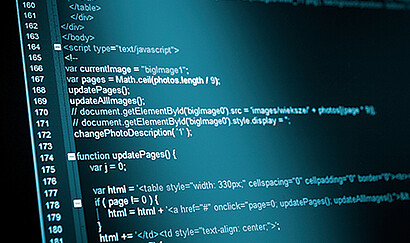Skills
Interfaces: The all-rounders
December 16, 2019
Modern interface technology makes intelligent visualization solutions an affordable entry strategy into digital transformation.
The great vision of the 21st century, the Internet of Things, is the perfection of networked communication: In the not too distant future, we will live in a complex network that allows everything that is intelligent or can be artificially made intelligent to communicate with each other via the Internet using digital technology: People with people, people with machines and machines with machines - a complex undertaking, because not only the number of communicating objects is growing explosively, but also their "language center", the software, is constantly changing due to updates, new versions or individual adaptations. In addition, the framework conditions for communication are also changing: new legal regulations, changed market conditions, technological disruptions, etc.
But there is a magic word for the accomplishment of this enormous task: "interface". This term refers to the (physical and/or software) location where communication takes place in the data network, the point of contact between two or more hardware and software units. In order for the units to be able to talk to each other at this point, all the translator functions and know-how about the communication modalities must be available here: protocols, standards, operating modes, etc. Only then can each device, once it has identified itself, exchange information with each partner.
Therefore, the secret of digitization lies in the interface. It implements communication in the digital network. What's more, operational processes can be linked to central planning systems (ERP) via interfaces, so that certain events (recorded by cameras, for example) automatically initiate appropriate actions such as spare parts requests, service orders, etc. The ERP software can come from different manufacturers - intelligent interfaces reliably translate the foreign "languages".
The fast track to the digital future
Digital automation makes it possible to control the cooperation of the most diverse hardware and software systems without human intervention by using interface technology. Networked production and supply chains thus become intelligent value creation networks in which production and logistics merge into a single unit. This digital transformation leads to lower operating costs, increased efficiency and new, customer-oriented business models.
In view of the great complexity of digital structures and processes, many SMEs have the impression that digitization would overburden them financially and know-how-wise and are hesitant to implement it. Experience shows that modern technology can make the gradual entry into the digital age much easier and cheaper than feared.
With the appropriate interface know-how, digitization projects can be successful without costs exploding. The ability to integrate devices of all kinds into a digitally networked system allows companies to reuse existing infrastructures or machines. Thanks to this backward compatibility, it is not necessary to replace the growing equipment fleets, which are usually supplied by many different manufacturers. Intelligent interfaces network them with each other without any problems - an important element in investment protection. In addition, new devices - regardless of the manufacturer - can be easily integrated into the network.
Not only safety-relevant tasks can be automated with advanced interface technology, but also camera-supported monitoring and control of production and logistics processes. As a result, process safety and efficiency, but also failure safety and reliability of the networked systems reach a new dimension.
Visualization plus data - key technology for medium-sized businesses
In addition, the connection of cameras and data from business systems provides companies with a wealth of tools for automated security (e.g. for access controls), but also for the automatic documentation of processes. This minimizes liability risks - for example, by recording the condition of incoming and outgoing goods and their route through the company's facilities via cameras and barcode information and storing them in the ERP system. From tracking shipments to finding lost pallets, the technology's options are inexhaustible.
A particular advantage is that process automation "automatically" leads to optimization potential for routine processes. Data reconciliation, for example, now takes place much faster through direct communication between machines and information systems and is stored in real time in the planning software - the amount of human and financial resources is reduced, while at the same time the susceptibility to errors is reduced. The future belongs to the visualization of processes, combined with the connection to the data resources in the company. For medium-sized businesses, this is a key technology in the struggle for future competitiveness. It is necessary to abandon this hesitant attitude and set the right course in good time.
Back


